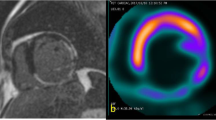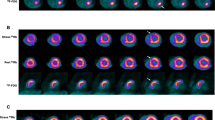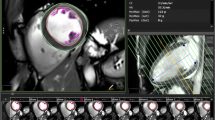Abstract
Background
Of various nuclear medicine techniques, F-18/flourodeoxyglucose (FDG) positron emission tomography (PET) is considered as the best modality for the assessment of viable myocardium (VM). In this study, we compared the diagnostic accuracy of nitrate augmented Tc-99m tetrofosmin gated G-single-photon emission computed tomography (SPECT) with FDG PET.
Methods
54 consecutive cases of angiographically proven CAD with severe LV dysfunction were enrolled in the study. The patients underwent Tc-99m tetrofosmin G-SPECT and FDG PET as per the standard protocols and were compared.
Results
SPECT data analysis indicated functional abnormalities in 661/918 myocardial segments. F-18 FDG PET revealed VM in 496/661 segments. The diagnostic accuracy of baseline NAC, postnitrate NAC, baseline AC, and postnitrate AC Tc-99m tetrofosmin SPECT was 84%, 87%, 90%, and 94%, respectively. κ values for NAC baseline, NAC postnitrate, AC baseline, and AC postnitrate Tc-99m tetrofosmin G-SPECT were 0.65, 0.70, 0.77, and 0.85, respectively. Attenuation correction revealed viability additionally in 46 segments which were non-viable on NAC postnitrate study (P < .001). Nitrate augmentation showed viability additionally in 25 segments which were non-viable on AC baseline scan (P = .004). On patient-based analysis FDG PET changes the management only in 13% (7/54) of patients.
Conclusions
Nitrate augmented AC Tc-99m tetrofosmin G-SPECT shows excellent (κ = .85) agreement with FDG PET. FDG PET changes management only in 13% of the patients. Tc-99m tetrofosmin G-SPECT being more widely available and cheaper imaging modality can be reliably used to detect VM where FDG PET is not available.



Similar content being viewed by others
References
Mann DL. Heart failure and cor pulmonale. In: Kasper DL, Braunwald E, Fauci AS, Hauser SL, et al., editors. Harrison’s principles of internal medicine. 17th ed. New York: McGraw-Hill; 2008. p. 1443-53.
Jessup Likoff M, Chandler S, Kay H. Clinical determinants of mortality in chronic congestive heart failure secondary to idiopathic dilated or to ischaemic cardiomyopathy. Am J Cardiol 1987;59:634-8.
Travin MI, Bergmann SR. Assessment of myocardial viability. Semin Nucl Med 2005;35:2-16.
Gerber BL, Vanoverschelde JL, Bol A, et al. Myocardial blood flow, glucose uptake, and recruitment of inotropic reserve in chronic left ventricular ischemic dysfunction: Implications for the pathophysiology of chronic myocardial hibernation. Circulation 1996;94:651-9.
Tamaki N, Kawamoto M, Tadamura E, et al. Prediction of reversible ischemia after revascularization: Perfusion and metabolic studies with positron emission tomography. Circulation 1995;91:1697-705.
Flameng WJ, Shivalkar B, Spiessens B, et al. PET scan predicts recovery of left ventricular function after coronary artery bypass operation. Ann Thorac Surg 1997;64:1694-701.
Bax JJ, Cornel JH, Visser FC, et al. Prediction of recovery of myocardial dysfunction after revascularization: Comparison of fluorine 18-fluorodeoxyglucose/thallium-201 SPECT, thallium-201 stress reinjection SPECT and dobutamine echocardiography. J Am Coll Cardiol 1996;28:558-64.
Dilsizian V, Rocco TP, Freedman NM, Leon MB, Bonow RO. Enhanced detection of ischemic but viable myocardium by the reinjection of thallium after stress-redistribution imaging. N Engl J Med 1990;323:141-6.
Iskandrian AS, Hakki AH, Kane SA, Goel IP, Mundth ED, Segal BL. Rest and redistribution thallium-201 myocardial scintigraphy to predict improvement in left ventricular function after coronary arterial bypass grafting. Am J Cardiol 1983;51:1312-6.
Udelson JE, Coleman PS, Metherall J, et al. Predicting recovery of severe regional ventricular dysfunction: Comparison of resting scintigraphy with 201 Tl and 99mTc-sestamibi. Circulation 1994;89:2552-61.
Maes AF, Borgers M, Flameng WJ, et al. Assessment of myocardial viability in chronic coronary artery disease using technetium-99m sestamibi SPECT: Correlation with histologic and positron emission tomographic studies and functional follow-up. J Am Coll Cardiol 1997;29:62-8.
Giorgetti A, Marzullo P, Sambuceti G, et al. Baseline/post-nitrate Tc-99m tetrofosmin mismatch for the assessment of myocardial viability in patients with severe left ventricular dysfunction: Comparison with baseline Tc-99m tetrofosmin scintigraphy/FDG PET imaging. J Nucl Cardiol 2004;11:142-51.
He W, Acampa W, Mainolfi C, et al. Tc-99m tetrofosmin tomography after nitrate administration in patients with ischemic left ventricular dysfunction: Relation to metabolic imaging by PET. J Nucl Cardiol 2003;10:599-606.
Acampa W, Cuocolo A, Petretta M, et al. Tetrofosmin imaging in the detection of myocardial viability in patients with previous myocardial infarction: Comparison with sestamibi and Tl-201 scintigraphy. J Nucl Cardiol 2002;9:33-40.
Matsunari I, Fujino S, Taki J, et al. Myocardial viability assessment with technetium-99m tetrofosmin and thallium-201 reinjection in coronary artery disease. J Nucl Med 1995;36:1961-7.
Yoshinaga K, Morita K, Yamada S, et al. Low-dose dobutamine electrocardiography-gated myocardial SPECT for identifying viable myocardium: Comparison with dobutamine stress echocardiography and PET. J Nucl Med 2001;42:838-44.
Pagano D, Bonser RS, Townend JN, Ordoubadi F, Lorenzoni R, Camici PG. Predictive value of dobutamine echocardiography and positron emission tomography in identifying hibernating myocardium in patients with postischemic heart failure. Heart 1998;79:281-8.
Baer FM, Theissen P, Schneider CA, et al. Dobutamine magnetic resonance imaging predicts contractile recovery of chronically dysfunctional myocardium after successful revascularization. J Am Coll Cardiol 1998;31:1040-8.
Travin MI, Bergmann SR. Assessment of myocardial viability. Semin Nucl Med 2005;35:2-16.
Zaret BL, Beller GA. Clinical nuclear cardiology. 3rd ed. Philadelphia: Current Medicine Group; 2009. p. 495-555.
Tilkemeier PL, Cooke CD, et al. Standardized reporting of radionuclide myocardial perfusion and function. ASNC Guidelines; 2010.
Cohen J. A coefficient of agreement for nominal scales. Educ Psychol Meas 1960;20:37-46.
Underwood SR, Bax JJ, vom Dahl J, et al. Imaging techniques for the assessment of myocardial hibernation. Report of a study group of the european society of cardiology. Eur Heart J 2004;25:815-36.
Beanlands RS, Nichol G, Huszti E, et al. F-18-fluorodeoxyglucose positron emission tomography imaging-assisted management of patients with severe left ventricular dysfunction and suspected coronary disease: A randomized, controlled trial (part-2). J Am Coll Cardiol 2007;50:2002-12.
Gerber BL, Ordoubadi FF, Wijns W, et al. Positron emission tomography using(18)F-fluoro-deoxyglucose and euglycaemic hyperinsulinaemic glucose clamp: Optimal criteria for the prediction of recovery of post-ischaemic left ventricular dysfunction. Results from the European Community Concerted Action Multicenter study on use of (18)F-fluoro-deoxyglucose positron emission tomography for the detection of myocardial viability. Eur Heart J 2001;22:1691-701.
Pagano D, Townend JN, Littler WA, Horton R, Camici PG, Bonser RS. Coronary artery bypass surgery as treatment for ischemic heart failure: The predictive value of viability assessment with quantitative positron emission tomography for symptomatic and functional outcome. J Thorac Cardiovasc Surg 1998;115:791-9.
Slart RHJA, Agool A, et al. Nitrate administration increases blood flow in dysfunctional but viable myocardium, leading to improved assessment of myocardial viability: A PET study. J Nucl Med 2006;47:1307-11.
Matsunari I, Boning G, Ziegler SI, et al. Attenuation-corrected 99mTc-tetrofosmin single-photon emission computed tomography in the detection of viable myocardium: Comparison with positron emission tomography using 18 F-fluorodeoxyglucose. J Am Coll Cardiol 1998;32:927-35.
Slart RH, Bax JJ, Sluiter WJ, van Veldhuisen DJ, Jager PL. Added value of attenuation-corrected Tc-99m tetrofosmin SPECT for the detection of myocardial viability: Comparison with FDG SPECT. J Nucl Cardiol 2004;11:689-96.
Author information
Authors and Affiliations
Corresponding author
Rights and permissions
About this article
Cite this article
Raja, S., Singh, B., Rohit, M.K. et al. Comparison of nitrate augmented Tc-99m tetrofosmin gated SPECT imaging with FDG PET imaging for the assessment of myocardial viability in patients with severe left ventricular dysfunction. J. Nucl. Cardiol. 19, 1176–1181 (2012). https://doi.org/10.1007/s12350-012-9607-9
Received:
Accepted:
Published:
Issue Date:
DOI: https://doi.org/10.1007/s12350-012-9607-9




